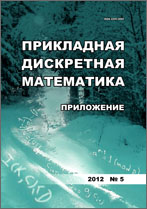|
This article is cited in 3 scientific papers (total in 3 papers)
Mathematical Methods of Cryptography
Constructions of non-endomorphic perfect ciphers
N. V. Medvedeva, S. S. Titov
Urals State University of Railway Transport, Ekaterinburg
Abstract:
This work is dealing with constructions of Shannon perfect ciphers (which are absolutely immune against the attack on ciphertext, according to Shannon). Based on the equivalence relation on the set of keys, sufficient conditions are obtained for that the encoding tables of non-endomorphic (endomorphic) perfect ciphers do not contain Latin rectangles (squares). Key equivalence refers to the following: two different keys are equivalent in cipher-value $x_i$ if the cipher-value $x_i$ on these keys is encrypted to the same code designation. In this case, pairwise different keys $k_1, k_2, k_3,\ldots , k_{n-1}, k_n$ form a cycle of length $n$ if there is such a sequence of cipher-values that: 1) the neighboring cipher-values are different; 2) the keys $k_1, k_2, k_3,\ldots , k_{n-1}, k_n, k_1$ are sequentially equivalent in the corresponding cipher-values. If $n$ is an odd number, then the keys $k_1, k_2,\ldots , k_n$ form an odd-length cycle. It is proved that if the keys $k_1, k_2, \ldots , k_n$ form an odd-length cycle, then this encoding table does not contain Latin rectangles. Example of such constructions is given.
Keywords:
perfect ciphers, endomorphic ciphers, non-endomorphic ciphers.
Citation:
N. V. Medvedeva, S. S. Titov, “Constructions of non-endomorphic perfect ciphers”, Prikl. Diskr. Mat. Suppl., 2020, no. 13, 51–54
Linking options:
https://www.mathnet.ru/eng/pdma495 https://www.mathnet.ru/eng/pdma/y2020/i13/p51
|

| Statistics & downloads: |
| Abstract page: | 79 | | Full-text PDF : | 56 | | References: | 16 |
|




 Contact us:
Contact us: Terms of Use
Terms of Use
 Registration to the website
Registration to the website Logotypes
Logotypes








 Citation in format
Citation in format 
